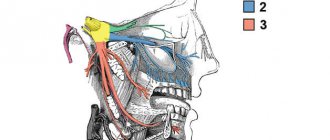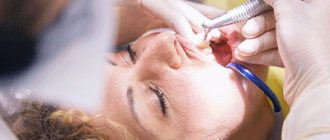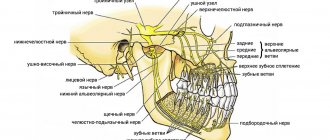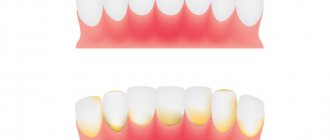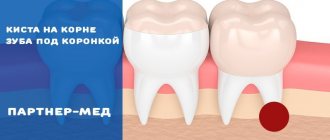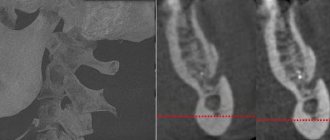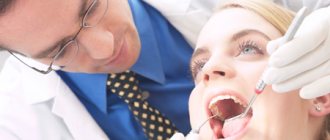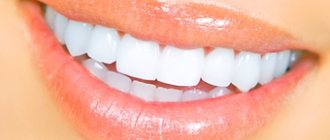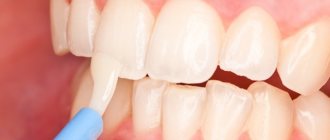Like any part of our body, our gums can also become injured. The tactics of the planned treatment depend on the volume and nature of the damage received. Only with properly organized treatment will trauma to the gums not leave serious consequences. When any oral disease appears without the necessary treatment, manifestations of a weakened body and complications are possible.
Despite the fact that the gums are protected from the outside by the muscle tissue of the lips, they are easily exposed when talking, eating, or laughing. This is facilitated by the fact that facial muscles in humans are quite well developed. Therefore, gums can easily suffer injuries of varying severity.
Why does pain occur?
Soft tissue may hurt due to:
- Enlarged lymph nodes
- A wisdom tooth that is starting to erupt
- Getting food between teeth
- Injuries received as a result of a fight, blow or bad fall
- Suppuration.
One of the causes of pain is injury. In dental practice, they are usually divided into two categories:
- Mechanical damage to the gums. A fairly common type that occurs in both adults and children. The reasons can be very diverse, but they are all related to physical effects. Falls or impacts may cause damage in one way or another. People often injure the soft tissues of the oral cavity and teeth during sports activities. Mechanical injuries are easier to diagnose because their presence can be determined visually during an examination by a doctor. They are accompanied by swelling, bruising and bleeding. An experienced dentist will help solve the problem, write out prescriptions, and select appropriate medications.
- Chemical. This category includes injuries caused by exposure to harsh chemicals. There are situations when a person, in a hurry and confused, drinks vinegar instead of water, resulting in a burn to the oral cavity. Exposure to various acids will inevitably lead to serious consequences. Teeth also suffer.
The gums are inflamed
Inflammation of the gums can be superficial or involve deeper tissues in the pathological process. As a rule, it is accompanied by swelling, pain, bleeding and bad breath. You should not underestimate gum inflammation, because in fact it is a source of infection in your oral cavity, which can lead to tooth loss.
Causes
The gums can become inflamed for the following reasons:
- deposits of tartar in the cervical area: its uneven edges injure the gums, causing it to become swollen, loose and bleeding. The accumulation of bacteria that feed on dental plaque only aggravates inflammation, causing gingivitis;
- periodontal pockets: tartar deposits peel off the edge of the gum from the neck of the tooth, making it easier for bacteria living on them to penetrate the root system of the tooth and provoke the emergence of a source of infection there;
- periodontitis is an inflammatory disease of the periodontium, which is accompanied by a weakening of the ligamentous apparatus of the teeth and, in advanced cases, leads to their loss;
- mechanical damage: may occur due to incorrectly placed fillings, braces or dentures. In this case, to relieve inflammation, it will be enough to eliminate the cause that caused such a problem;
- caries: with deep caries, the infection can penetrate into the pulp and further along the root canals, causing the formation of gumboil, granuloma, etc.;
- lack of vitamins and minerals;
- endocrine disorders;
- gastrointestinal pathology.
Diagnostics
If the gums are inflamed, the doctor needs to determine whether the cause of the pathological process is local or general. Because in case of disturbances in the functioning of the endocrine system and gastrointestinal tract, in order to eliminate the problem, it is necessary to treat the underlying disease.
For this purpose, the dentist conducts an audit of the patient’s oral health. For this purpose, a visual inspection method is used, as well as x-ray examination. If violations of the dental system are detected, appropriate treatment is prescribed.
Treatment
Treatment of a patient whose gums are inflamed is selected individually and depends on the degree of periodontal damage and the presence of infectious foci.
When diagnosing tartar deposits and periodontal pockets, professional oral hygiene is carried out, during which all supra- and subgingival deposits are removed.
If the infection has penetrated into the root canals, the doctor performs endodontic treatment of the tooth using the most suitable method for the patient.
If periodontitis, severe gum recession, or loose teeth are diagnosed, the dentist prescribes surgical treatment aimed at maintaining the ligamentous apparatus of the tooth.
Read more:
- What does a periodontist do?
Mechanical damage to the gums: how to treat
Damage to the gums is a serious problem, which in some cases requires the intervention of a specialist. It is better not to self-treat gum damage. But you can familiarize yourself with general recommendations on how to behave immediately after an injury:
- Use an antiseptic solution and rinse your mouth twice a day
- Take painkillers
- Eat on the other side so as not to provoke an attack of pain
- If possible, consult a dentist as soon as possible to avoid suppuration and other complications.
Possible consequences
The most common complications of tooth trauma include gum inflammation. Due to severe mechanical damage, soft tissues become injured and inflamed, which slows down the recovery process. The following negative factors can aggravate the problem:
- decreased immunity,
- lack of vitamins D and group B,
- trauma to the oral mucosa,
- damage to the gums by hard brushes, dental floss or orthodontic appliances.
Inflammation of the gums can be local and generalized. In any case, you should consult a specialist.
Acute and chronic injuries
Acute gum injuries include injuries resulting from soft tissue injury:
- Too hard bristles of a toothbrush
- Fish bone
- toothpick
Bruised gums are possible from falls and fights. Thermal burns are also possible if you consume too hot food or drink.
Chronic injuries include those that a person receives as a result of prolonged exposure to irritating agents on soft tissue:
- Food constantly stuck between teeth
- Poor quality filling that extends beyond the tooth
- Orthodontic devices (braces, plates)
- Poorly fitted clasp on a prosthesis
- Edges of a crown on a tooth
Mechanical injuries may be accompanied by slight bleeding. And with chemical and thermal injuries, erosion forms at the site of damage. With chronic injuries, purulent discharge may form on the gums. In advanced cases, surgery may be required. But more often local treatment is enough. Minor injuries can be treated with special healing balms prescribed by the dentist.
When is a visit to the dentist necessary?
It is advisable to seek help immediately as soon as the following symptoms appear:
- General health has deteriorated significantly
- subfebrile body temperature is within the range of 37.2? C - 37.5? C
- a slight increase in the level of leukocytes in the CBC was noted
- formations (seals) detected
With a weakened immune system, the injured area can take quite a long time to heal. If, after examination, the dentist determines that the gums (or teeth) are damaged as a result of the impact of the denture, the patient will be referred to an orthopedist.
How to treat mechanical gum damage
To help the patient, the doctor will first eliminate the causes of inflammation:
- if necessary, remove the foreign body
- will replace low quality fillings
- will consider alternative options to replace uncomfortable dentures
- recommend a new toothbrush
If the gums are damaged by a toothbrush, the accessory must be replaced, choosing it according to the degree of stiffness of the bristles. Your doctor will help you make your choice. Below we will consider how doctors suggest treating mechanical damage to the gums:
- Treatment and procedures for pain relief of the damaged area. Applications with lidocaine solution help. Some dentists recommend propolis preparations to patients for these purposes.
- Treatment of inflammation. To prevent infection, the drugs Chlorhexidine, Miramistin or furatsilin will be prescribed. You can also use traditional medicine: decoctions of chamomile and sage. Gels against gum inflammation show a good effect: Metrogyl Denta, Cholisal.
- Healing procedures. Gels, ointments and balms containing vitamin A and E work well.
If the size of the damage is small, then sutures are not required. It is better to check with a professional about treating gum damage rather than trying to prescribe medications on your own.
Treatment of gum inflammation after tooth trauma
Dentists draw up a treatment plan taking into account the clinical picture, diagnosis and diseases suffered by the patient. To eliminate gum inflammation, experts most often prescribe:
- treatment of soft tissues with anti-inflammatory gels,
- rinsing the mouth with antiseptic solutions,
- professional teeth cleaning.
If there are signs of a bacterial infection, your doctor may prescribe antibacterial medications. They must be taken strictly as prescribed by a specialist. It is also important to use suitable toothbrushes and other personal hygiene products.
Preventive measures
It is rare to avoid gum injury under certain circumstances, but there are some preventive measures you should know:
- Try to eat carefully. Without being distracted by conversations or watching movies. This will minimize the likelihood of mechanical injury or burns.
- Teeth should be treated on time. Immediately after the onset of painful sensations, you should consult a dentist.
- Prosthetic procedures take place in reliable and certified clinics.
- Do not self-medicate under any circumstances; do not take antibiotics or other serious medications without a doctor’s prescription.
- Try to brush your teeth properly. If necessary, use a soft-bristled brush.
About gum damage in a child
Children can often damage their teeth and gums due to their active lifestyle. Parents should always pay great attention to proper teeth cleaning. Quite often, young children injure themselves with toothbrushes. In most cases, there will be a slight bruise that will go away on its own over time. If an injury occurs as a result of a blow or fall, bleeding comes from the gums, and the tooth is noticeably loose, the first thing to do is contact a pediatric dentist.
Young children are not prescribed “adult” drugs, so you should not try to cure a child by simply giving him an anti-inflammatory drug. Under no circumstances should you risk the health of children whose immune systems are not yet stable. Even if only the mucous membrane is visually damaged and the tooth is intact, this does not mean that the root or nerve of the tooth is not damaged. A doctor's examination is necessary to close any access of infection through the damaged area. Treatment of gum injuries in children begins with a visual examination and is carried out taking into account the intensity of the damage. In controversial situations, the pediatric dentist may prescribe additional tests, for example, computed tomography. Remember, regular preventive examinations for children and adults always contribute to oral health.
Diagnosis of periodontitis
Diagnostics includes a visual examination to determine the presence of problems and analysis of complaints to make a preliminary diagnosis. Then the patient is sent for additional examination:
- orthopantomogram - a circular image of the entire jaw;
- X-ray - X-ray of periodontitis on a specific tooth using a targeted image;
- periodontogram - measuring the depth of periodontal pockets;
- urine and blood analysis - determination of infections and diseases in the body.
The symptoms of the disease are similar to those of other dental pathologies; the doctor’s task is to make an accurate diagnosis for effective treatment.
- With periodontal disease, there is no bleeding, swelling of the gums and periodontal pockets, there is no inflammation, since the main cause is age-related changes, diabetes mellitus and cardiac dysfunction. Read more about periodontal disease in a separate article.
- With gingivitis, periodontal pockets and tooth mobility are not observed, there is no exposure of the roots, and inflammation affects only the gum tissue. Find out about the symptoms of the disease here.
- Stomatitis is accompanied by plaque on the tongue and ulcers on the mucous membrane, bleeding and inflammation of the gums, tooth mobility and exposure of the roots are absent. About the types and signs of the disease in a separate article.
